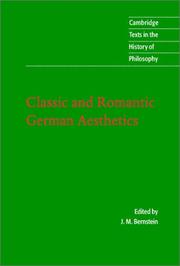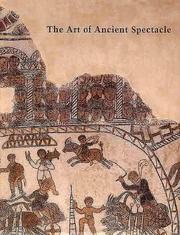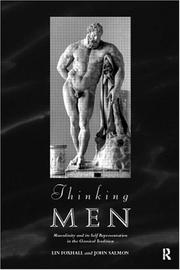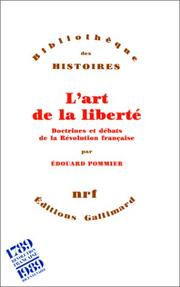| Listing 11 - 20 of 20 | << page >> |
Sort by
|

ISBN: 1107131243 128043354X 0511803737 113914734X 0511178468 0511063768 0511057431 0511330561 0511072228 9780511063763 9780511057434 9780521806398 0521806399 9780511803734 9780511072222 0521001110 9780521001113 Year: 2003 Publisher: Cambridge : Cambridge University Press,
Abstract | Keywords | Export | Availability | Bookmark
 Loading...
Loading...Choose an application
- Reference Manager
- EndNote
- RefWorks (Direct export to RefWorks)
This 2002 volume brings together major works by German thinkers, writing just prior to and after Kant, who were enormously influential in this crucial period of aesthetics. These texts include the first translation into English of Schiller's Kallias Letters and Moritz's On the Artistic Imitation of the Beautiful, together with translations of some of Hölderlin's most important theoretical writings and works by Hamann, Lessing, Novalis and Schlegel. In a philosophical introduction J. M. Bernstein traces the development of aesthetics from its still rationalist and mimetic construction in Lessing, through the optimistic construal of art and/or beauty as the appearance of human freedom in the work of Schiller, to Hölderlin's darker vision of art as the memory of a lost unity, and the variations of that theme - of an impossible striving after the lost ideal - which are found in the work of Schlegel and Novalis.
Aesthetics, German. --- Arts, Classical --- Classical arts --- German aesthetics --- Aesthetics. --- Philosophy. --- Aesthetics, German --- Aesthetics --- Philosophy --- Philosophy, German --- Esthétique allemande --- Philosophie allemande --- Hölderlin, Friedrich, --- Novalis, --- Schlegel, Friedrich von, --- Arts and Humanities
Book
ISBN: 1350042374 1350042358 Year: 2019 Publisher: London : Bloomsbury Publishing,
Abstract | Keywords | Export | Availability | Bookmark
 Loading...
Loading...Choose an application
- Reference Manager
- EndNote
- RefWorks (Direct export to RefWorks)
"This book explores Symbolist artists' fascination with ancient Greek art and myth, and how the erotic played a major role in this. For a brief period at the end of the 19th century the Symbolist movement inspired artists to turn inwards to the unconscious mind, endeavouring to unveil the secrets of human nature through their symbolic art. But above all their greatest interest, and fear, was man (and woman's) sexuality. Building upon the traditions of Academic neoclassicism, but fired with a new zeal, they turned back to Greek art and myth for inspiration"--

ISSN: 00917338 ISBN: 0300077335 9780300077339 Year: 1999 Volume: 56 34
Abstract | Keywords | Export | Availability | Bookmark
 Loading...
Loading...Choose an application
- Reference Manager
- EndNote
- RefWorks (Direct export to RefWorks)
oudheid --- geschiedenis --- theater --- architectuur (bouwwerken) --- profane iconografie --- spel --- dans --- sport --- Arts and society --- -Arts, Classical --- -Entertainment events --- -Amusements --- Classical arts --- Arts --- Arts and sociology --- Society and the arts --- Sociology and the arts --- History --- Social aspects --- Arts, Classical --- Entertainment events --- -History --- -Classical arts --- Amusements --- Mediterranean region --- Congresses --- Festivals in art --- Performing arts --- Greece --- Rome --- Rites and ceremonies --- Performance --- Theater --- Spectacular, The --- theater, toneel, toneelvoorstelling --- burgerlijke architectuur; gebouwen; huisvesting --- dansen --- Arts and society - Mediterranean Region - Congresses --- Entertainment events - Mediterranean Region - Congresses --- Arts, Classical - Mediterranean Region - Congresses --- Arts and society - Greece - Congresses --- Arts and society - Rome - Congresses --- Rites and ceremonies - Greece - History - Congresses --- Rites and ceremonies - Rome - History - Congresses --- Performance - Social aspects - Greece - Congresses --- Performance - Social aspects - Rome - Congresses --- Theater - Rome - History - Congresses --- Theater - Greece - History - Congresses --- Spectacular, The - Congresses
Book
ISBN: 272880222X 9782728802227 Year: 1996 Volume: 7 Publisher: Paris : Presses de l'Ecole Normale Supérieure,
Abstract | Keywords | Export | Availability | Bookmark
 Loading...
Loading...Choose an application
- Reference Manager
- EndNote
- RefWorks (Direct export to RefWorks)
Civilization [Ancient ] --- Congresses --- Civilization, Ancient --- Civilization, Classical, in art --- Civilisation ancienne --- Civilisation ancienne dans l'art --- Congrès --- Ecole normale supérieure (France). --- Art, European --- Arts, Classical --- 7.045 --- 87.04 --- 7.045 Iconografie: allegorieen; symbolen; dodendansen; emblemata --- Iconografie: allegorieen; symbolen; dodendansen; emblemata --- Classical arts --- Art, Modern --- European art --- Nouveaux réalistes (Group of artists) --- Zaj (Group of artists) --- 87.04 Klassieke literatuur: thema's --- Klassieke literatuur: thema's --- Themes, motives --- Influence --- École normale supérieure (France). --- Art, European - Themes, motives - Congresses. --- Arts, Classical - Influence - Congresses. --- Art --- Influence de l'antiquite --- Art moderne --- Civilisation moderne --- Art européen --- Civilisation --- Influence classique. --- Dans l'art.
Book
ISBN: 9789004361393 9004361391 9789004410657 9004410651 Year: 2019 Volume: 307 41 Publisher: Leiden: Brill,
Abstract | Keywords | Export | Availability | Bookmark
 Loading...
Loading...Choose an application
- Reference Manager
- EndNote
- RefWorks (Direct export to RefWorks)
"This monograph studies the constructions of 'impressive' historical descent manufactured to create 'national', regional, or local antiquities in early modern Europe (1500-1700), especially the Netherlands. This was a period characterised by important political changes and therefore by an increased need for legitimation; a need which was met using historical claims. Literature, scholarship, art and architecture were pivotal media that were used to furnish evidence of the impressively old lineage of states, regions or families. These claims related not only to Classical antiquity (in the generally-known sense) but also to other periods that were regarded as periods of antiquity, such as the chivalric age. The authors of this volume analyse these intriguing early modern constructions of appropriate 'antiquities' and investigate the ways in which they were applied in political, intellectual and artistic contexts in Europe, especially in the Northern Low Countries"--
Arts, Classical --- Civilization, Modern --- Classical antiquities --- Classicists --- Influence. --- Classical influences. --- Political aspects --- Study and teaching --- Study and teaching. --- Attitudes. --- Europe. --- Netherlands. --- Politics --- Art --- History of civilization --- Ancient history --- Antique, the --- influence --- anno 1500-1599 --- anno 1600-1699 --- Europe --- Attitudes --- Influence --- Classical influences --- Antiquities, Classical --- Antiquities, Grecian --- Antiquities, Roman --- Archaeology, Classical --- Classical archaeology --- Roman antiquities --- Antiquities --- Archaeological museums and collections --- Art, Ancient --- Classical philology --- Modern civilization --- Modernity --- Civilization --- Renaissance --- Classical arts --- Classical scholars --- Classics scholars --- Hellenists --- Latinists --- Philologists --- Scholars --- History --- 930.85.44 --- 930.85.44 Cultuurgeschiedenis: Renaissance --- Cultuurgeschiedenis: Renaissance --- Civilization, Classical --- Classical antiquities - Study and teaching - Netherlands --- Classical antiquities - Political aspects - Netherlands --- Classicists - Attitudes --- Arts, Classical - Influence --- Civilization, Modern - Classical influences --- Classical antiquities - Study and teaching - Europe --- Classical antiquities - Political aspects - Europe --- cultuurgeschiedenis --- kunst en politiek
Book
ISBN: 9781789141504 1789141508 Year: 2020 Publisher: London : Reaktion Books,
Abstract | Keywords | Export | Availability | Bookmark
 Loading...
Loading...Choose an application
- Reference Manager
- EndNote
- RefWorks (Direct export to RefWorks)
"The Renaissance artist Raphael is known for his extraordinary frescoes, his sublime Madonnas, devotional altarpieces, architectural designs, and his inventive prints and tapestries. It was his use of ancient Roman models - classical sculptures, reliefs and paintings - that formed his much admired classical style, and influenced the styles of many later artists.0In 'Raphael and the Antique' Claudia La Malfa gives a full account of Raphael's prodigious career, from central Italy when he was 17 years old, to Perugia, Siena and Florence, where he first met with Leonardo and Michelangelo, to Rome where he became one of the most feted artists of the Renaissance. This book focuses and highlights Raphael's re-invention of classical models, his draughtsmanship and his concept of art, which he pursued and was still striving to perfect at the time of his death aged only 37, in 1520."
Art, Renaissance. --- Art de la Renaissance --- Raphael, --- Raphaël --- Criticism and interpretation. --- Critique et interprétation. --- Raphael --- Arts, Classical --- Art, Renaissance --- 75.07 --- Raphael (Raffaelo Sanzi(o)) 1483-1520 (° Urbino, Italië) --- Schilderkunst ; eind 15de-begin 16de eeuw ; Rafaël --- Schilderkunst ; Italië ; Hoog-Renaissance ; Rafaël --- Classical arts --- Influence --- Schilderkunst ; schilders A-Z --- Sanzio, Raffaele --- Raffaello Sanzio --- Santi, Raffaello --- Sanzio, Raffaello --- Raffael --- Raffaello --- Urbino, Raffaello da --- Sanctius, Raphae, --- Urbinas, Raphael Sanctius --- Rafaėlʹ --- Raffaele Sanzio --- Sanzi, Raffaello --- invloed van antieke kunst
Book
ISBN: 353409400X Year: 1983 Publisher: Darmstadt : Wissenschaftliche Buchgesellschaft (WBG),
Abstract | Keywords | Export | Availability | Bookmark
 Loading...
Loading...Choose an application
- Reference Manager
- EndNote
- RefWorks (Direct export to RefWorks)
7.04 <38> --- 87.04 --- Arts, Classical --- Odysseus (Greek mythology) --- -Classical arts --- Iconografie. Iconologie. Onderwerpen van kunstzinnige uitbeelding--Oud-Griekenland --- Klassieke literatuur: thema's --- Art --- Homer --- Odysseus (Greek mythology) in literature --- -Iconografie. Iconologie. Onderwerpen van kunstzinnige uitbeelding--Oud-Griekenland --- 87.04 Klassieke literatuur: thema's --- 7.04 <38> Iconografie. Iconologie. Onderwerpen van kunstzinnige uitbeelding--Oud-Griekenland --- Hóiméar --- Hūmīrūs --- Homeros --- Homerus --- Gomer --- Omir --- Omer --- Omero --- Ho-ma --- Homa --- Homérosz --- האמער --- הומירוס --- הומר --- הומרוס --- هومر --- هوميروس --- 荷马 --- Ὅμηρος --- Гамэр --- Hamėr --- Омир --- Homero --- 호메로스 --- Homerosŭ --- Homērs --- Homeras --- Хомер --- ホメーロス --- ホメロス --- Гомер --- Homeri --- Hema --- Pseudo-Homer --- Pseudo Omero --- Homère --- Classical arts --- Homer. --- Homerus.

ISBN: 0415146356 Year: 1998 Volume: v. 7 Publisher: London ; New York, NY : Routledge,
Abstract | Keywords | Export | Availability | Bookmark
 Loading...
Loading...Choose an application
- Reference Manager
- EndNote
- RefWorks (Direct export to RefWorks)
Art, Greek --- Art, Roman --- Masculinity in literature. --- Masculinity in art. --- Men in literature. --- Men in art. --- Men --- Art grec --- Art romain --- Masculinité dans la littérature --- Masculinité dans l'art --- Hommes dans la littérature --- Hommes dans l'art --- Hommes --- ro: ed. by --- Masculinité dans la littérature --- Masculinité dans l'art --- Hommes dans la littérature --- Arts, Classical --- Civilization, Classical --- Classical literature --- Literature and society --- Masculinity in art --- Masculinity in literature --- Men in art --- Men in literature --- Self-knowledge in literature --- Human males --- Human beings --- Males --- Effeminacy --- Masculinity --- Male figure in art --- Masculinity (Psychology) in literature --- Masculinity (Psychology) in art --- Literature, Classical --- Literature --- Literature, Ancient --- Greek literature --- Latin literature --- Classical civilization --- Civilization, Ancient --- Classicism --- Classical arts --- Male authors&delete& --- History and criticism --- Male authors

ISBN: 2070723275 9782070723270 Year: 1991 Publisher: [Paris] : Gallimard,
Abstract | Keywords | Export | Availability | Bookmark
 Loading...
Loading...Choose an application
- Reference Manager
- EndNote
- RefWorks (Direct export to RefWorks)
On ne propose pas ici un ouvrage de plus sur les œuvres d'art ni sur les institutions artistiques de l'époque révolutionnaire, mais bien plutôt une étude sur la manière dont les hommes de la Révolution ont parlé de l'art et, plus particulièrement, de la peinture et de la sculpture. Du printemps de 1789 à l'automne de 1799, un discours artistique se forme et s'infléchit : il est inspiré par les thèmes fondateurs de la liberté et de la régénération, dont les contradictions et les ambiguïtés éclatent dès 1790 avec les débats sur l'iconoclasme et le patrimoine. Le premier problème qui se pose à la conscience révolutionnaire est en effet celui de gérer l'héritage de l'Ancien Régime. Le pouvoir parvient à élaborer en l'an II une doctrine qui ne variera plus. Au même moment, et au prix d'une étonnante manipulation de l'histoire, la Révolution revendique la succession de l'art universel que son discours nationalise au nom de la liberté. La conservation ou l'annexion des chefs-d'œuvre du passé se justifie avant tout par la nécessité de disposer des modèles nécessaires, selon la tradition académique, à la régénération de l'art. Il s'agit alors de savoir si la vocation des artistes français est de ressusciter Athènes, ou bien de chercher dans les annales de la République les thèmes d'un art triomphal. Aux questions sur l'unité ou la discontinuité de la Révolution, cet ouvrage voudrait apporter un élément de réponse. Les thèses élaborées en l'an II sont développées, plutôt que contestées, par les proclamations officielles, les traités théoriques, l'enseignement et la critique des années du Directoire. Tandis que la pensée lucide et courageuse d'un opposant comme Quatremère de Quincy domine de très haut les plaidoyers de circonstance, la véritable nouveauté réside dans la lente et encore timide émergence d'un statut historique qui apporte à l'art une promesse de dignité et de sauvegarde.
Histoire des mentalités --- --France --- --Art --- --Révolution française, --- Cultural property --- Protection --- History --- France --- Art and the revolution --- Cultural policy --- Arts, Classical --- -Cultural property --- -Cultural heritage --- Cultural patrimony --- Cultural resources --- Heritage property --- National heritage --- National patrimony --- National treasure --- Patrimony, Cultural --- Treasure, National --- Property --- World Heritage areas --- Classical arts --- Influence --- -History --- -France --- -Art and the revolution. --- -Historiography. --- -Influence --- Pʻŭrangsŭ --- Frankrig --- Francja --- Frant︠s︡ii︠a︡ --- Prantsusmaa --- Francia (Republic) --- Tsarfat --- Tsorfat --- Franḳraykh --- Frankreich --- Fa-kuo --- Faguo --- Франция --- French Republic --- République française --- Peurancih --- Frankryk --- Franse Republiek --- Francland --- Frencisc Cynewīse --- فرنسا --- Faransā --- Franza --- Republica Franzesa --- Gallia (Republic) --- Hyãsia --- Phransiya --- Fransa --- Fransa Respublikası --- Franse --- Францыя --- Frantsyi︠a︡ --- Французская Рэспубліка --- Frantsuzskai︠a︡ Rėspublika --- Parancis --- Pransya --- Franis --- Francuska --- Republika Francuska --- Bro-C'hall --- Френска република --- Frenska republika --- França --- República Francesa --- Pransiya --- Republikang Pranses --- Γαλλία --- Gallia --- Γαλλική Δημοκρατία --- Gallikē Dēmokratia --- فرانسه --- Farānsah --- צרפת --- רפובליקה הצרפתית --- Republiḳah ha-Tsarfatit --- פראנקרייך --- 法国 --- 法蘭西共和國 --- Falanxi Gongheguo --- フランス --- Furansu --- フランス共和国 --- Furansu Kyōwakoku --- Francija --- Ranska --- Frankrike --- Cultural heritage --- France (Provisional government, 1944-1946) --- Art and the revolution. --- Historiography. --- Art et révolution --- Liberté --- Art --- Art et politique --- Dans l'art --- Philosophie --- Dans l'art. --- Art et révolution. --- Fa-lan-hsi --- Falanxi --- Frankrijk --- Frant︠s︡ --- Frant︠s︡ Uls --- Франц --- Франц Улс --- 法蘭西 --- 프랑스 --- Révolution française, 1789-1799 --- Cultural property - Protection - France - History - 18th century --- France - History - Revolution, 1789-1799 - Art and the revolution --- France - Cultural policy - History - 18th century
Book
ISBN: 9780691240244 Year: 2007 Publisher: Princeton, N.J. : Princeton University Press,
Abstract | Keywords | Export | Availability | Bookmark
 Loading...
Loading...Choose an application
- Reference Manager
- EndNote
- RefWorks (Direct export to RefWorks)
In Roman Eyes, Jas Elsner seeks to understand the multiple ways that art in ancient Rome formulated the very conditions for its own viewing, and as a result was complicit in the construction of subjectivity in the Roman Empire. Elsner draws upon a wide variety of visual material, from sculpture and wall paintings to coins and terra-cotta statuettes. He examines the different contexts in which images were used, from the religious to the voyeuristic, from the domestic to the subversive. He reads images alongside and against the rich literary tradition of the Greco-Roman world, including travel writing, prose fiction, satire, poetry, mythology, and pilgrimage accounts. The astonishing picture that emerges reveals the mindsets Romans had when they viewed art--their preoccupations and theories, their cultural biases and loosely held beliefs. Roman Eyes is not a history of official public art--the monumental sculptures, arches, and buildings we typically associate with ancient Rome, and that tend to dominate the field. Rather, Elsner looks at smaller objects used or displayed in private settings and closed religious rituals, including tapestries, ivories, altars, jewelry, and even silverware. In many cases, he focuses on works of art that no longer exist, providing a rare window into the aesthetic and religious lives of the ancient Romans.
Arts, Classical. --- Visual perception. --- Aesthetics, Roman. --- Roman aesthetics --- Optics, Psychological --- Vision --- Perception --- Visual discrimination --- Classical arts --- Psychological aspects --- Adoration. --- Aelius Aristides. --- Aeschylus. --- Agalmatophilia. --- Anchises. --- Ancient Greek art. --- Ancient Rome. --- Anecdote. --- Anthropomorphism. --- Apuleius. --- Art history. --- Atargatis. --- Bathing. --- Bibliography. --- Capitoline Museums. --- Castration. --- Christian apologetics. --- Conflation. --- Cooling. --- Cult image. --- Cupid and Psyche. --- De Dea Syria. --- Deity. --- Diana and Actaeon. --- Drapery. --- Ekphrasis. --- Epigram. --- Epithet. --- Eroticism. --- Genre. --- Greco-Roman world. --- H II region. --- Hagiography. --- Hare Krishna (mantra). --- Harpocrates. --- Hellenization. --- Hierapolis. --- Hieros gamos. --- Hydrogen line. --- Iconography. --- Illustration. --- In the Water. --- Indulgence. --- Initiation. --- Ionic Greek. --- Ionization. --- Late Antiquity. --- Leucippe and Clitophon. --- Libation. --- Mimesis. --- Narrative logic. --- Narrative. --- Neo-Attic. --- Number density. --- Oculus. --- Our Choice. --- Parody. --- Philostratus. --- Photon. --- Piety. --- Poetry. --- Polytheism. --- Posture (psychology). --- Praxiteles. --- Procession. --- Pubic hair. --- Putto. --- Queen of Heaven. --- Reionization. --- Religion and sexuality. --- Religious image. --- Rite. --- Roman art. --- Satire. --- Sculpture. --- Second Sophistic. --- Self-consciousness. --- Sensibility. --- Serapis. --- Sexual intercourse. --- Sincerity. --- Social reality. --- Sophist (dialogue). --- Sophistication. --- Star formation. --- Subjectivity. --- Temperature. --- The Golden Ass. --- The Last Sentence. --- The Sea Monster. --- Theatricality. --- Venus Anadyomene. --- Verisimilitude (fiction). --- Verisimilitude. --- Viewing (funeral). --- Voluptas. --- Voyeurism. --- Vulva. --- Writing. --- Zeuxis. --- Romans --- Aesthetics. --- Religious life.
| Listing 11 - 20 of 20 | << page >> |
Sort by
|

 Search
Search Feedback
Feedback About
About Help
Help News
News